Like Andrea mentioned, we spent the first few days of our vacation in Koyasan, alternately gazing at enormous temples and graveyards, fighting off insects, eating tasty shojin ryori, and getting scolded for every little mistake by a Buddhist monk with a hunchback. Once we were done there, we headed back to our original transfer point, Osaka, to take in the contrast of big city life.
Osaka is a much bigger city than
Kanazawa, at about 6 or 7 times the population. As the largest municipality of the Hokuriku region, Kanazawa has most of the amenities of a large Japanese city, but we lack a lot of the esoteric niche areas and stores you'll find in Tokyo or Osaka.
We spent a large amount of our time at Osaka's Den-den Town, an area devoted to electronics stores, video game stores, arcades, collectibles, and numerous other subcultures with varying degrees of
weirdness. Case in point, there was actually an entire multi-level store devoted to
Gundam robot toys and models. Not my thing, but I guess it's sort of nice to know that it's there, and that a store that big can be devoted to something that specific and still be sustainable.
It was the second time we'd ever been to Den Den Town (and Osaka in general), and what we were most interested in returning to was a pair of game stores devoted primarily to the burgeoning trend of retro gaming; that is, the console systems of the 80s and 90s, such as the NES, Super NES, Sega Genesis, etc. The best known of those two stores was Super Potato, which is widely regarded as the mecca of old and rare game cartridges and disks. Not to be overlooked is Retro Game Revival, less than 100 feet down the block, which doesn't have quite as impressive a stock but generally has cheaper prices and some occasional good finds among the innumerable shelves of games you've never heard of.

Here's a Mario statue inside Super Potato, plastered with various fliers and hand-written signs:

The one thing we were most excited about coming with was this:
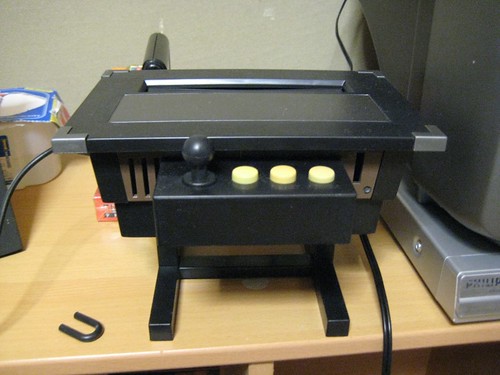
This is a generic version of the Famicom, or the Japanese version of what we know in the US as the NES. This one happens to be shaped as a miniature cocktail-style arcade machine. Sadly, the joystick doesn't work, and probably would be too small to be useful if it did; but two of the buttons function as on/off and reset. It now sits beside our TV any time we need an NES fix, Japan style.
Of course, the machine itself is useless without games, and boy, what games we found in various used bins and crammed anonymously in endless shelves!

What you see to your left is Transformers: Mystery of Convoy. When I saw it, I thought "Cool! A Transformers game for only a buck! Might as well give it a shot." What I didn't know is that this game is notorious in Japan for how horrible it is; in particular, the game is so pointlessly difficult that you die after one hit. You get hit once, you die. You touch an enemy in any way, you die. Unless you time everything perfectly, this will happen within about 10-15 seconds of the game starting. I haven't even made it out of the first level after trying about 20 times and I'm not sure I'd be willing to try. Still, I am happy to own a piece of gaming history, even if it's only historical for being a piece of crap.
I also bought an Ultraman game for 300 yen (a little over 3 dollars). Hey, it's Ultraman... he flies around and blows stuff up, so it'll make for a fast-paced action game, right? Wrong. Turns out it's a ponderous RPG where Ultraman begins by talking on the phone in what looks like a hotel lobby, and then goes outside where he engages in molasses-slow turn based fighting against the same three enemies every 5 inches or so. Lesson learned; cheap for a reason, I guess.

The exception to the various disappointments in random games we picked up is that I found a 100-yen sumo wrestling game that I'd never heard of before. It's mostly repetitive, random button-mashing, but it's a lot more fun than either of the other games I mentioned. Unfortunately, I think the reason I may have it got it so cheap is that the graphics are glitchy, possibly due to the cartridge being damaged.
So, all in all, despite the disappointments I mentioned, I'm pretty happy with my 20 dollar faux-cocktail Famicom. It's just one more piece of evidence in my ongoing series of discovering just how much Japanese kids have it better than we ever did.
One other neat part of Den-Den town is Super Position, a tightly-packed and often-crowded store devoted to all those toys and things that are available for sale in capsule machines. Rows of machines like these are fairly common (although not as common as drink vending machines, which you can see about every 10 feet, even in very rural areas!). So, if it's ever been sold in a capsule machine in the last 2 decades, it's probably at Super Position.
While there were a lot of neat little toys, nothing really demanded that I buy it until I saw this:
That's right. It's a capsule toy of a capsule toy. It's about an inch and a half tall, and inside the upper chamber you'll find miniature capsules. And the thing actually works; if you turn the little dial, out pops a capsule. It's too small to actually contain anything, but for 3 bucks, the idea of it was too irresistible to not buy.











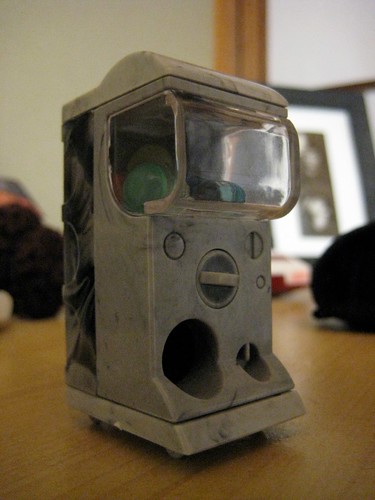
 For dinner, we went to
For dinner, we went to 
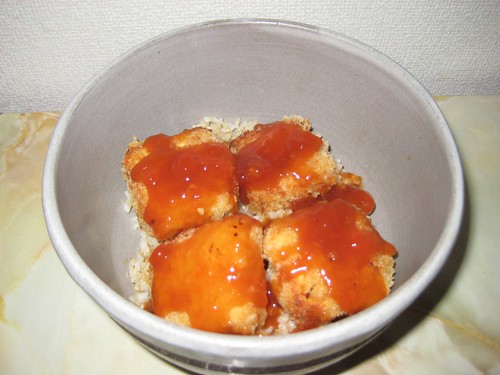
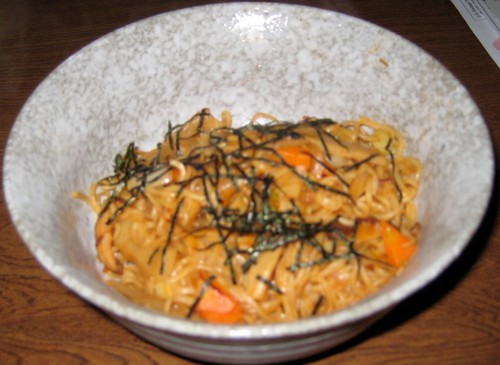
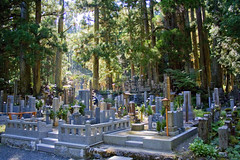







 y own interest in the subject, I know a lot of this stuff can be pretty boring in the abstract. That's why I found
y own interest in the subject, I know a lot of this stuff can be pretty boring in the abstract. That's why I found  1) Garlic. Not just any garlic, though; "Inspirational" garlic. Tasted like regular garlic to me, but maybe inspiration has a subtle flavor.
1) Garlic. Not just any garlic, though; "Inspirational" garlic. Tasted like regular garlic to me, but maybe inspiration has a subtle flavor.